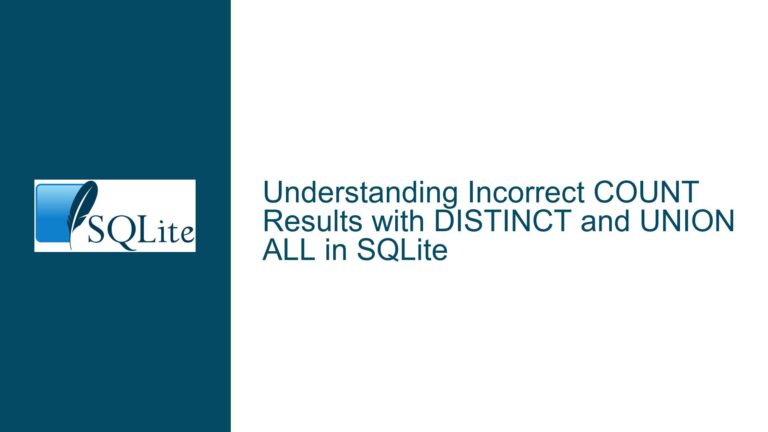Unraveling SQLite GROUP BY Constants: Unexpected Grouping and Arbitrary Row Selection
Issue Overview: GROUP BY Constants and Non-Deterministic Outputs
Core Mechanism of GROUP BY in SQLite
The GROUP BY clause in SQLite partitions query results into groups based on specified expressions. When a constant (e.g., GROUP BY 0.5, GROUP BY 'fixed_value') is used, SQLite treats it as a grouping key that evaluates to the same value for all rows. This collapses the entire result set into a single group. For example:
CREATE TABLE t0 (c0 TEXT NOT NULL UNIQUE, c1 TEXT);
INSERT INTO t0 VALUES ('1', NULL), (x'0A'||'2', NULL);
SELECT c0 FROM t0 GROUP BY 0.5;
Here, GROUP BY 0.5 groups all rows into one. The c0 column is not aggregated, so SQLite selects its value from an arbitrary row in the group. This behavior diverges from standard SQL, where non-aggregated columns in SELECT must either appear in GROUP BY or be wrapped in aggregate functions.
Key Observations from the Forum Thread
Constants vs. Column Ordinals:
GROUP BY 1refers to the first column in theSELECTlist (column ordinal syntax).GROUP BY 0.5is treated as a literal, collapsing all rows into a single group.- This duality causes confusion, as users familiar with column ordinals in
ORDER BYmay incorrectly apply the logic toGROUP BY.
Determinism of Output:
- The selected value for non-aggregated columns (e.g.,
c0) is not truly random but depends on internal factors like row visitation order, which may vary across executions or schema changes. - Example: If the table’s physical storage order changes due to a
VACUUMoperation, the "arbitrary" value ofc0might differ.
- The selected value for non-aggregated columns (e.g.,
Documentation Gaps:
- SQLite’s documentation does not explicitly clarify how constants in
GROUP BYare handled compared to column ordinals. - Users often mistake this behavior for a bug when encountering non-reproducible results.
- SQLite’s documentation does not explicitly clarify how constants in
Edge Cases Highlighted in the Discussion
- Using non-integer literals (e.g.,
GROUP BY 'yeehaw') forces a single group. - Mixing constants with valid grouping expressions (e.g.,
GROUP BY c1, 0.5) creates one group per distinctc1value, with all rows sharing the samec1collapsed into subgroups by the constant. - Explicit vs. implicit grouping: Queries without
GROUP BYbut with aggregate functions implicitly group all rows into one (similar toGROUP BY 1.0).
Possible Causes: Why GROUP BY Constants Lead to Unexpected Results
1. Misapplication of Column Ordinal Syntax
Developers accustomed to ORDER BY 1 (sorting by the first column) may incorrectly assume GROUP BY 1 groups by the first column. While SQLite supports column ordinals in GROUP BY, non-integer constants like 0.5 are treated as literals, not ordinals. This leads to unintended single-group formation.
2. Lack of Strict Mode Enforcement
Unlike PostgreSQL or MySQL, SQLite does not enforce strict checks on non-aggregated columns in SELECT when using GROUP BY. This permissiveness allows queries like SELECT c0 FROM t0 GROUP BY 0.5 to run without errors, even though c0 is neither aggregated nor part of the grouping key.
3. Undocumented Handling of Constants
The forum thread reveals that SQLite’s treatment of constants in GROUP BY is an intentional but underdocumented feature. Users expecting standard SQL behavior (which prohibits non-aggregated columns) are caught off guard.
4. Dependency on Internal Row Order
When multiple rows exist in a group, SQLite selects values from the first row it encounters. This order can change due to:
- Index additions/removals
- Data modifications (e.g.,
INSERT,DELETE) - Database optimization operations (e.g.,
REINDEX)
Troubleshooting Steps, Solutions & Fixes
Step 1: Diagnose the Query’s Intent
Scenario 1: Intended Single-Group Aggregation
If collapsing all rows into one group is intentional:
- Use aggregate functions for non-grouped columns:
SELECT MAX(c0) AS example_c0 FROM t0 GROUP BY 0.5; - Add
DISTINCTto clarify intent:SELECT DISTINCT MAX(c0) FROM t0;
Scenario 2: Accidental Single-Group Formation
If the constant was a typo (e.g., meant to use a column name):
- Replace the constant with the correct column or expression:
SELECT c0 FROM t0 GROUP BY c0; -- Groups by actual c0 values
Step 2: Enforce Deterministic Outputs
Use Aggregates for Non-Grouped Columns
To eliminate arbitrariness:
SELECT
MIN(c0) AS min_c0,
MAX(c0) AS max_c0,
COUNT(*) AS row_count
FROM t0
GROUP BY 0.5;
Leverage SQLite’s Bare Column Optimization
When using MIN() or MAX(), SQLite selects the value from the row containing the extremum:
SELECT
c0,
MAX(c1) AS max_c1
FROM t0
GROUP BY 0.5; -- c0 comes from the row with MAX(c1)
Step 3: Avoid Constants in GROUP BY
Explicit Column References
Replace constants with column names or aliases:
SELECT
c0 AS alias_c0,
c1
FROM t0
GROUP BY alias_c0; -- Valid in SQLite
Column Ordinal Syntax (If Intentional)
Use GROUP BY 1 to group by the first SELECT column:
SELECT
c0,
COUNT(*)
FROM t0
GROUP BY 1; -- Groups by c0
Step 4: Enable Strict Mode via PRAGMA (SQLite 3.37+)
Activate strict typing and grouping checks:
PRAGMA strict = ON;
PRAGMA query_only = ON; -- Optional safety net
This throws errors for ambiguous GROUP BY usage but does not fully replicate standard SQL enforcement.
Step 5: Schema and Index Adjustments
Add NOT NULL Constraints
Reduce ambiguity in non-aggregated columns:
CREATE TABLE t0 (
c0 TEXT NOT NULL UNIQUE,
c1 TEXT NOT NULL -- Prevent NULL-related indeterminism
);
Create Covering Indexes
Stabilize row order within groups:
CREATE INDEX idx_t0_c0 ON t0(c0, c1);
SELECT c0, c1 FROM t0 GROUP BY 0.5; -- c0/c1 from index order
Step 6: Cross-Check with EXPLAIN QUERY PLAN
Analyze how SQLite processes the query:
EXPLAIN QUERY PLAN
SELECT c0 FROM t0 GROUP BY 0.5;
Look for SCAN TABLE (full table scan) vs. USE INDEX (deterministic order).
Solutions for Common Anti-Patterns
Anti-Pattern 1: Assuming Constants Group by Column Position
Incorrect:
SELECT c0, c1 FROM t0 GROUP BY 1; -- Groups by c0 (ordinal 1)
SELECT c0, c1 FROM t0 GROUP BY 1.5; -- Groups by constant, single group!
Fix: Use column names for clarity:
SELECT c0, c1 FROM t0 GROUP BY c0;
Anti-Pattern 2: Omitting Aggregates for Non-Grouped Columns
Incorrect:
SELECT c0, c1 FROM t0 GROUP BY c0; -- c1 is arbitrary
Fix: Apply aggregates:
SELECT c0, MAX(c1) FROM t0 GROUP BY c0;
Anti-Pattern 3: Overloading GROUP BY for DISTINCT
Incorrect:
SELECT c0 FROM t0 GROUP BY c0; -- Redundant, use DISTINCT
Fix: Prefer DISTINCT for uniqueness:
SELECT DISTINCT c0 FROM t0;
Best Practices to Prevent GROUP BY Issues
- Explicit Column Naming: Always reference columns by name in
GROUP BY, avoiding ordinals and constants. - Aggregate All Non-Grouped Columns: Ensure every
SELECTcolumn is either inGROUP BYor wrapped in an aggregate function. - Index Strategically: Create indexes on
GROUP BYcolumns to stabilize row order. - Validate with EXPLAIN: Use
EXPLAIN QUERY PLANto detect full table scans or unstable sort orders. - Adopt Strict Mode: Enable
PRAGMA strict=ONto surface ambiguous queries early.
By adhering to these principles, developers can avoid the pitfalls of SQLite’s flexible GROUP BY implementation while leveraging its performance benefits.






